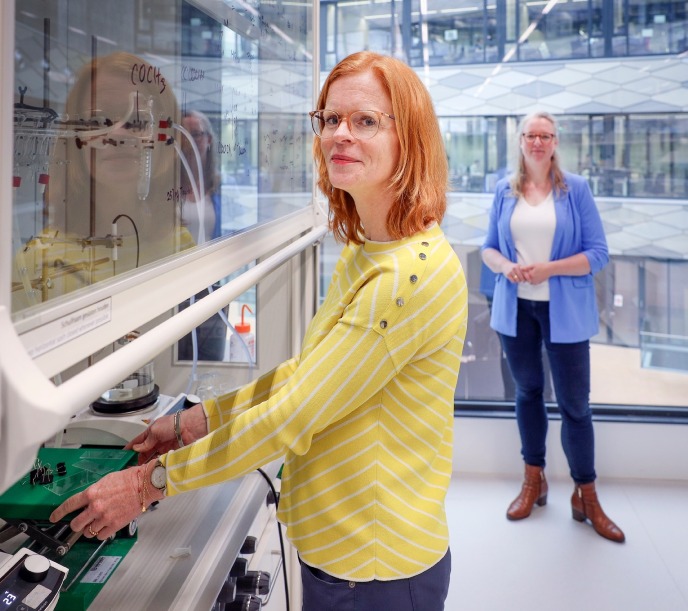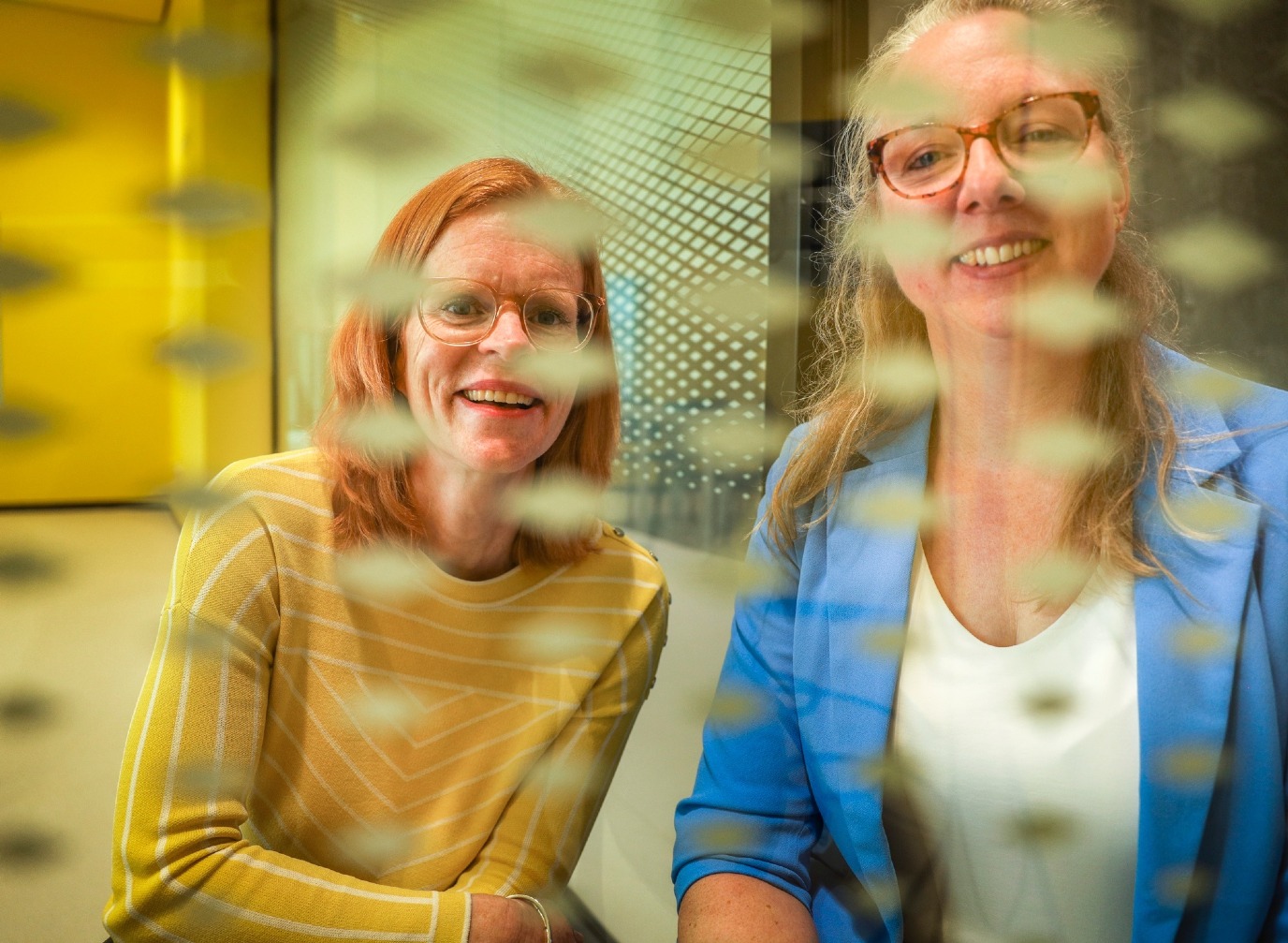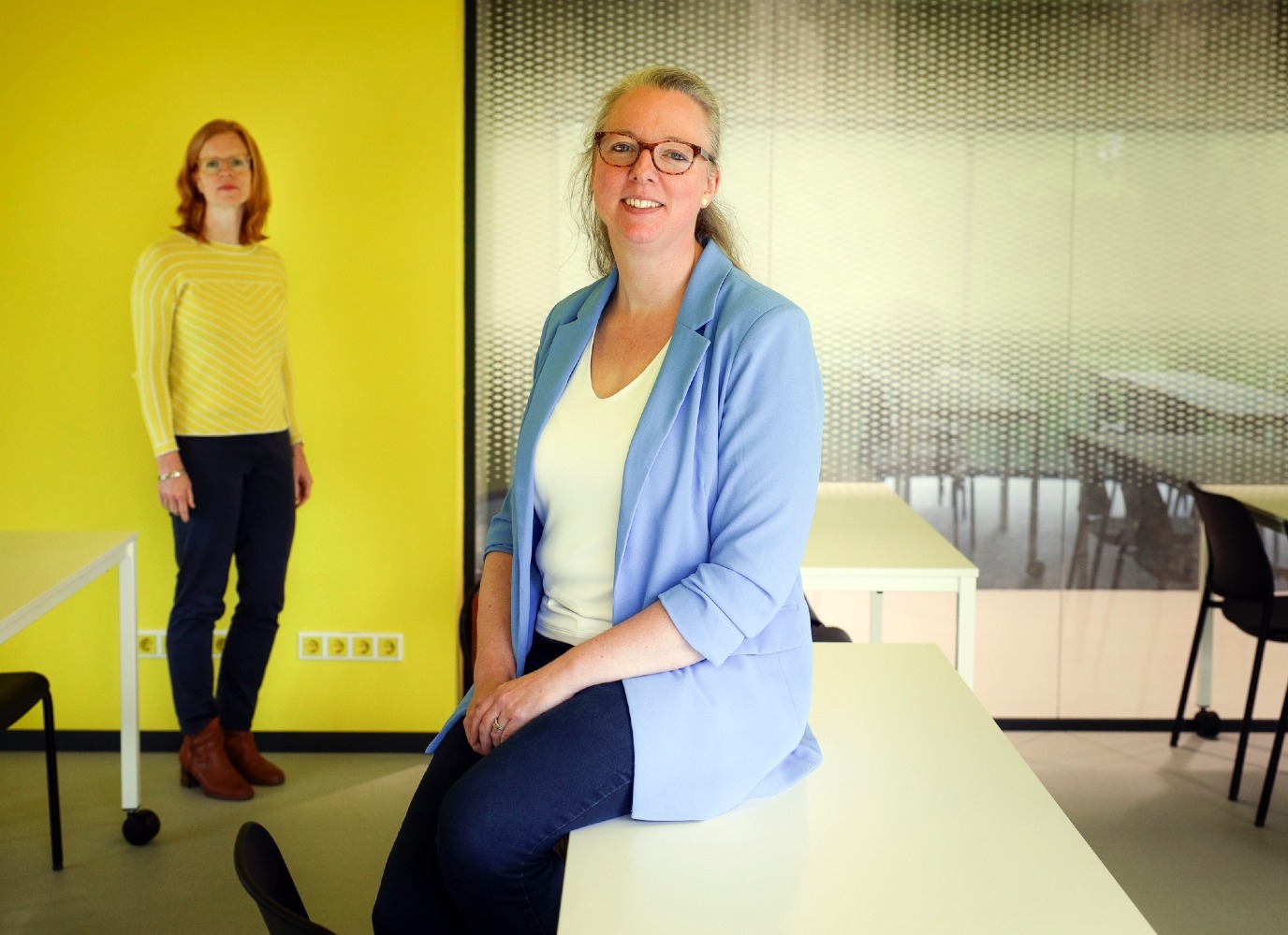From oyster mushroom to overalls

A T-shirt made from fungi — or mycelium textile, to be more exact. It would be a great step toward a more sustainable fashion industry. At least it could be if the material could be developed in such a way that it can be used for clothing and if consumers accept it and want to wear it. Marleen Kamperman, Professor of Polymer Science, and Marijke Leliveld, associate professor of Consumer Ethics, have combined their expertise and are working on both questions at the same time.
Text: Marrit Wouda, Corporate Communication UG / Photos: Henk Veenstra
Oyster mushrooms
Mycelium textile is a fairly new but promising material: it is made from the roots of mushrooms, in this case oyster mushrooms. It is quick and easy to cultivate and biodegradable. ‘At the moment, the material still has a paper-like quality, but it’s probably also possible to turn it into something resembling leather,’ Kamperman says. She is specialized in developing new materials, polymers mostly. Marijke Leliveld is specialized in consumer behaviour. ‘I’m mainly thinking about the question: what makes that people find the material interesting? What do they need in order to accept a material made out of fungi?’ she explains.

A box of mushrooms
We have the Young Academy Groningen (YAG) away day to thank for this remarkable collaboration. ‘My immediate thought was: I need her! says Kamperman with a big smile. Kamperman was already indirectly involved in various projects about more sustainable materials. When Marijke told me that she focuses on sustainable consumption, I knew right away that I had to have a longer conversation with her.’ Leliveld was also immediately excited. ’It looks very strange on paper; how am I supposed to collaborate with a Professor of Polymer Science?’ Leliveld says. ‘But you did bring a box of mushrooms to my inaugural lecture!’ Kamperman says, grinning. ‘That’s truly one of the fun things of the YAG, that such remarkable collaborations can arise.’
2-in-1
Developing a new material and doing market research at the same time. It sounds like these are two completely different research questions; why would you put them together in one project? Kamperman thinks that this assumption is actually the reason it often goes wrong. ‘If you’re making something without knowing if people have a need for it, you can develop a beautiful material that is subsequently shelved.’ So, the product needs to align with the consumer’s wishes. ‘Do people want something really durable, such as real leather, or is there no demand for that and would we do better to focus on something that can only be used once and can then be buried in the garden?’ she follows up. ‘I think it’s a really good idea to go back and forth between material development and consumer insights and to test things,’ Leliveld adds. ‘So we know what to spend the most time on during the development phase. By taking the consumer aspect into account, we can get a clear vision of what the end result should be.’
Usable & loved
Creating a material that is sustainable, biodegradable, and usable is quite tricky. It is really difficult to make it washable, or to ensure it is long-lasting or comfortable to wear. ‘You can easily improve the properties of a material by adding a synthetic layer. For example, you can add elastane to cotton fabrics. It’s more comfortable to wear, but it’s no longer biodegradable,’ Kamperman explains. In their opinion, it is a little utopian to search for some kind of holy grail that solves everything. ‘We sometimes think that it has to be completely perfect, that it’s completely right, but maybe we should look for ‘good enough’,’ Kamperman says. ‘Something that works for a number of applications but not for everything.’
Would people want to wear clothes made of fungi? That is the question of course. ‘Let’s be honest: we find leather a perfectly normal material, but it is, technically, a dead animal. Apparently, we can find that normal, so that should also be possible with mycelium textile,’ according to Leliveld. It also partly depends on how you market the material. ‘We usually find new, innovative things a little bit scary, so we won’t go down that road.’ She continues: ‘If you market something as sustainable, you lose the people who don’t really care about that. So we have to look at what catches on among consumers to determine which strategy is most fruitful.’

Differences
Although they immediately inspired each other, the start of their collaboration took some effort: their research methods differed tremendously. ‘The only thing we have in common, methodologically speaking, is that we both do experiments. I conduct behavioural experiments, but Marleen experiments using Erlenmeyer flasks in the lab!’ Leliveld says, laughing. Initially, the two researchers hoped they could hire a PhD student through one of YAG’s programmes. They wrote a proposal that was approved, but they soon concluded that it would not work. ‘It was actually not doable to mix all of that in one person. Especially if we also wanted to be able to properly supervise that person. So we decided to cancel the proposal. Kamperman adds: ‘People talk a lot about interdisciplinary research, but I have now fully realized that you have to think really carefully how you go about it.’
Going ahead after all
Thanks to a €100,000 donation from the Gratama Foundation, the project can now go ahead after all. With the money, they can hire two student assistants — one for each researcher, so it does not all have to be mixed in one person. Kim Poldner, Professor by special appointment of Regional and Circular Economic Development at the Faculty of Economics and Business, and industrial designer Tjeerd Veenstra will also be involved in the project. ‘They each bring their own expertise which gives us the freedom to use our own knowledge and enrich each other’s knowledge,’ Leliveld explains. They hope to form a proper foundation in the next two years that can be used for further research.
More information
More news
-
11 December 2025
Stormy planets and an unexpected atmosphere
-
09 December 2025
Are robots the solution?
